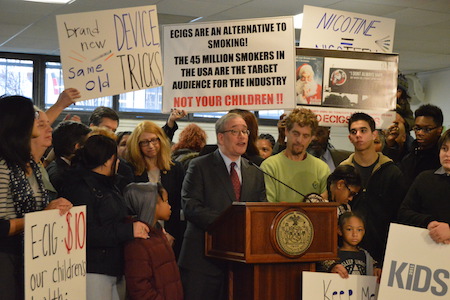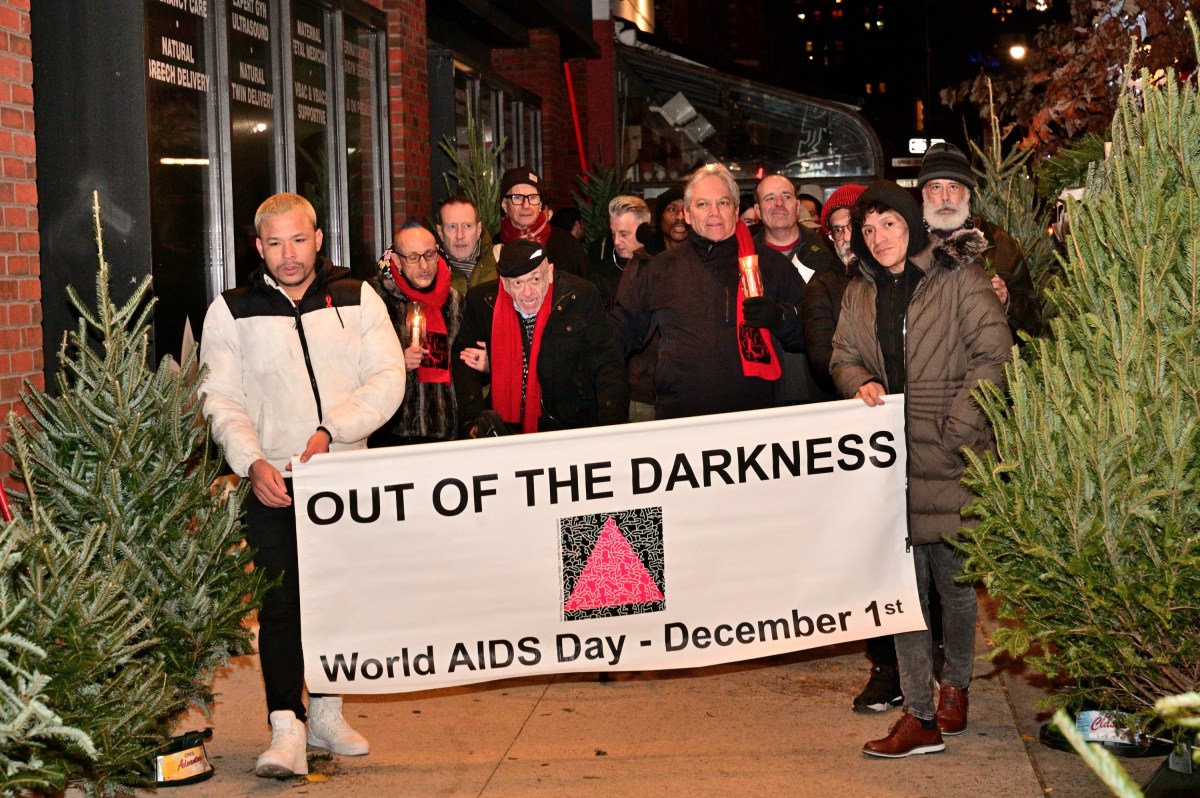
BY JACKSON CHEN | The city’s comptroller and public advocate teamed up on Sunday to make a stand against electronic cigarette companies whose advertising targets children, as they called for federal investigation and regulation of the industry.
Joined by anti-smoking groups and other local politicians at the Godard Riverside Community Center on Columbus Avenue at 88th Street, Comptroller Scott Stringer and Public Advocate Letitia James accused e-cigarette, or vaping, companies of using similar marketing techniques for reaching youth as the big tobacco companies did in decades past.
“You’d think that tobacco companies would have learned their lesson from $250 billion dollars in fines,” Stringer said, referring to the 1998 settlement between major tobacco companies and various state attorneys general to end cigarette marketing to kids. “But they’re back at it again, using the same old marketing tricks to seduce our teens into getting hooked on e-cigarettes.”
Despite 2013 city legislation restricting the sale of e-cigarette products to people 21 and over, Stringer said companies have used Santa Claus, cartoon characters, and concert and sports sponsorships to deviously market toward the younger demographic.
For Upper West Side State Assemblymember Linda Rosenthal, the e-cigarette issue is nothing new, as she’s sponsored several bills that attempt to regulate the industry. On top of those efforts, Rosenthal is joining the latest push to restrict companies who market vaping toward kids.
“Each and every day, the children of New York State are exposed to ads promoting electronic cigarettes by an industry that exists outside the scope of almost all government regulation,” Rosenthal said. “Without swift action… we risk addicting a new generation of young people on a dangerous habit.”
In the politicians’ call to action, Stringer and James rallied for e-cigarette companies to follow the same rules as cigarette giants, who cannot advertise toward children, and for the Federal Trade Commission to investigate current marketing practices.
Additionally, the two want the Food and Drug Administration to regulate e-cigarettes under the label of tobacco products, which stipulates requirements regarding addiction warnings, certain marketing restrictions, and a national age minimum for purchase of these products.
“We need regulations to prevent e-cigarette companies from using these tactics to compromise the health of our children,” James said. “No company that promotes a product that is dangerous to our health should be allowed to use seductive ads to attract our kids.”

To further make their point, Stringer noted data from the Centers for Disease Control and Prevention (CDC) that showed e-cigarette use jumped from 1.5 percent in 2011 to 13.4 percent in 2014 among high school-aged youth. Meanwhile, cigarette use amongst the same group of teens dropped from 15.8 percent in 2011 to 9.2 percent in 2014.
In response, e-cigarette advocates on hand for the Stringer-James press event argued for an end to what they see as smoke and mirrors tactics by politicians in portraying vaping companies as evil.
Jeff Stier, a senior fellow at the National Center for Public Policy Research, a Washington-based conservative communications and research group, didn’t dispute the idea that e-cigarettes shouldn’t be marketed toward children.
“I’ll agree with them on one point: youth should be not using this product and companies shouldn’t be marketing to them,” he said.
But, Stier, who is neither a smoker nor an e-cig user, argued that demonizing e-cigarettes and slapping harsh regulations on them would compromise the effort to offer smokers trying to quit a safer alternative.
Stier, claiming the politicians’ comments were misleading, said that when companies sell a cherry-flavored e-cigarette, they’re aiming toward adults who look for sweet flavors to keep them off their old habits.
“They find that when they have these sweet flavor e-cigarettes,” Stier said of e-cig users, “it gives them the nicotine their body craves without the harmful byproducts of combustible cigarettes.”
Gregory Conley, president of the American Vaping Association, said a watermelon-flavored vapor product helped him quit smoking five and a half years ago. He added that many adults who quit smoking are looking for a nicotine alternative that doesn’t have the odor and taste of tobacco.
“For those who continue to use nicotine who feel they can’t stay off of it, it keeps them using this product rather than inhaling burning smoke into their lungs,” Conley said.
To counter the CDC statistics that Stringer pointed out, Conley said the CDC also has numbers that show that 22 percent of former smokers who had the habit for less than a year currently use e-cigarettes and that among ex-long term smokers, 3.7 percent have now turned to e-cigarettes.
While Conley contended that the vaping industry is simply helping adults quit smoking, Patrick Kwan, the director of NYC Smoke-Free at Public Health Solutions, a non-profit advocacy group, recommended FDA-approved cessation devices instead.
“One key aspect is that for [nicotine] patches and gum, you’re being weaned off,” Kwan said. “When you are using e-cigarettes as a nicotine replacement, you’re not necessarily weaning yourself off.”
Kwan said that people actually take in more nicotine through vapor devices and said the worry regarding youth vaping is a matter of them not understanding the harmful effects of the drug coupled with the availability of a convenient method of consumption.
“Nicotine is dangerous for kids at any age, whatever device they’re coming from,” Kwan said.


































